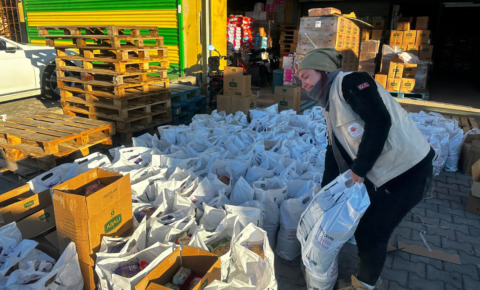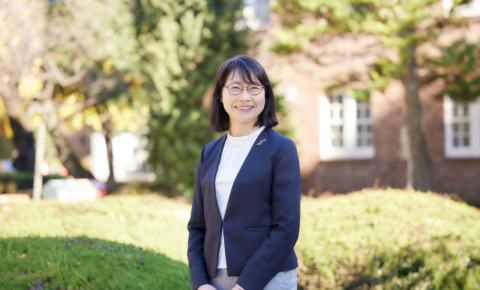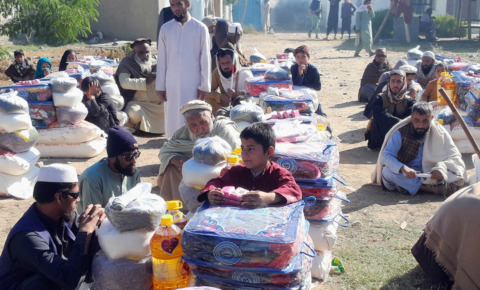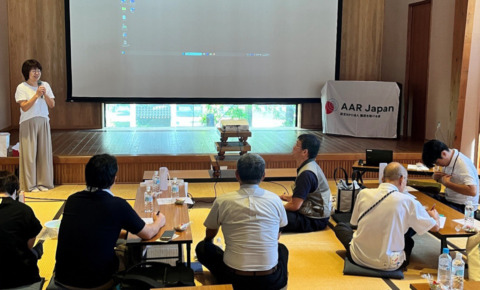“I am crying in my heart” 2.4 million people are still displaced: Six months after the earthquake in Turkey
01/08/2023
Six months have passed since the February 6 earthquake struck Turkey this year. With neighboring Syria, more than 57,000 people were killed in the disaster, and approximately 2.4 million people in Turkey alone live in harsh conditions in residential containers and tents.
AAR Japan [Association for Aid and Relief, Japan] began providing emergency assistance immediately after the disaster and has so far delivered food, hygiene products, and other supplies to a total of 62,400 people in the affected areas in southeastern Japan. Here are the voices of people who are trying their best to overcome the disaster.
Living in tents using the water supply in a park
After the earthquake, those unable to secure new housing were divided into two main groups: official shelters (official sites) established and operated by the Turkish government and unofficial camps (unofficial sites) where disaster victims set up tents or containers in vacant lots or parks to live. Unlike the official sites, which are well-equipped to some extent, the unofficial sites need more adequate support.
Unofficial sites are scattered throughout the urban area of Kahramanmaras, where Ayse, a 50-year-old housewife, lives with her husband and son in a tent set up in a large park. “The house we lived in was safe and sound despite that big earthquake,” she said. “However, after the earthquake, the rent, which was 550 Turkish Lira per month, jumped more than 15 times due to the housing shortage. We couldn’t afford to pay it, and we had to leave our house because the landlord wanted to evict us.”

Ayse living in a tent at an informal site
After living in a tent in another part of the city for about four months, Ayse and her family moved to their current informal site because it has running water and electricity. However, the water is from the park’s water supply, and the electricity is “stolen electricity,” which is drawn into the tent from the power lines (a common practice in regional cities in Turkey before the earthquake).
“My husband used to work as a garbage collector, but he lost his job after the earthquake. My son has a disability, so we receive a living subsidy for him, but our monthly income is about 2,800 Turkish Liras. I am diabetic, but I can’t even afford to buy medicine,” she says. Ayse confides in us.
After six months of crippling displacement, Ayse is exhausted. “Living in a tent is inconvenient, and I don’t feel safe because there is no key. There is only a small bed for my son. We wash our clothes by hand using the park’s water supply. We can never have enough soap and other hygiene supplies.”

A small bed was placed inside the small tent
“I really want to move to the official site,” said Ayse. However, to move to an official site, one’s home must be certified as either completely or partially destroyed, and in the case of Ayse and her family, neither of these conditions apply. Many other victims are in the same situation, she said.
Moreover, the Turkish government has announced its intention to close down unofficial sites in the city center gradually. This means that people like Ayse and others who are not eligible to enter official sites and are financially unable to rent new homes will have nowhere to go.
“We are told to get out of here, but we can’t go anywhere unless we have a new home. We have no prospects for the future. The earthquake hit, and we are as good as dead. We are always crying inside.” Ayse’s voice sounded like she was trying to squeeze out a few words.

Ayse talks about the hardships of evacuation life
Still, Ayse expressed her gratitude at the end. “There is no one to listen to us. They need to listen to us. We want people to know that we are living a very difficult evacuation life. Thank you so much for coming from far away Japan and supporting us and listening to us in this way.”
I want to move before winter comes
The earthquake devastated a village in Adiyaman Prefecture and destroyed almost all the houses. Most villagers lost their homes and live in shelters in residential containers. People are forced to live in informal sites within the village because they cannot continue farming as a means of livelihood if they move to official sites located far from the village.

A living container provided to the survivors
“The container is very small for five people. It gets very hot in the summer, but there are no air conditioners.” Yasin (40) and Rukie (33) are a family of five with three children. For a while after the earthquake, they lived in a tent in front of their collapsed house, but about three months later, the Turkish government provided them with a container, and they are now living in an unofficial site in the village.
Yasin said at a table in front of the container, “We lost all our furniture and daily necessities in the earthquake. We have been trying to get some things together since then, but we don’t have enough clothes for the children, and we also need cooking utensils and dishes. We also don’t have enough household items for washing and cleaning.”
The family used to earn their daily income as tenant farmers, but after the earthquake, the number of jobs drastically decreased, and the family lost their source of income. “Without support, we would not be able to make a living,” says Rukie, his wife. “We are also worried that our children are not getting an education because schools have been closed for so long.”

AAR staff interviewing Mr. Yasin (right)
According to the Turkish government’s reconstruction plan, the village will not be rebuilt on its original site but on another piece of land several kilometers away. The villagers will leave the land where they grew up and move to a new location. “We would like to stay where we are, but we know that is impossible, so we have no choice but to move to the new village. We want to move at least before the winter comes. I can’t imagine living through a cold winter in this container,” Yasin added.
The couple added, “Thanks to your support, we can now manage to make a living. We are very grateful that the people of Japan have not forgotten us. Thank you from the bottom of my heart.”
Medium- to long-term support for self-reliance
Six months after the earthquake, 800,000 people are said to be living on official sites and 1.6 million people on unofficial sites. At the official sites, containers are lined up in regular rows on well-developed sites, electricity, water, and sewage are running, and support such as food and sanitary supplies have been received.
In contrast, at unofficial sites, which were established spontaneously, most of the containers and tents are provided by the government and aid organizations, but there needs to be more support in the form of housing conditions and distribution of supplies. The Turkish government is focusing on expanding and supporting the official sites, and the gap between the two is widening.
Over the past six months, the rubble of collapsed buildings has been removed, and official sites have been built rapidly. Although reconstruction appears to progress steadily, the situation has not changed much since the disaster, especially for those living in unofficial sites, forced to live in harsh evacuation conditions. The number of people affected and the amount of support needed is so huge that it far exceeds what the Turkish government and aid organizations can handle. There is not enough support at all.

People gather at an informal site to distribute supplies
For the affected areas to truly recover, it is necessary to rebuild the buildings and help the survivors gain a means of livelihood and become self-reliant. It may take up to a few years for a new town to be built, but it will take many more years for Ayse and Yasin to return to the independent lives they enjoyed before the disaster.
AAR is focusing its relief efforts on people living in informal sites in more difficult circumstances and is also looking beyond the distribution of supplies to provide medium- and long-term support to help the survivors become self-reliant. We would like to ask for your continued understanding and cooperation in AAR’s support for the earthquake victims in Turkey.
Request for your support
We appreciate your cooperation with our emergency relief efforts in Turkey.



